Analysis of DSDV and AODV Routing Protocols in Wireless Networks
VerifiedAdded on 2023/01/23
|29
|4859
|85
Report
AI Summary
This report presents a detailed analysis of wireless sensor network simulations, focusing on the performance of DSDV and AODV routing protocols. The study utilizes the NetSim-2 and NAM simulation tools to model network behavior, including packet transmission and energy consumption across 20 network nodes. The report examines the behavior of the protocols under various conditions, analyzing factors such as node movement, energy loss, and packet dropping. The DSDV protocol demonstrates a uniform packet transmission rate, while AODV prioritizes energy efficiency by maximizing initial packet transmission. The analysis includes trace file records to evaluate energy usage and packet delivery, concluding with recommendations on the appropriate application of each routing protocol based on network requirements and energy constraints. The report also includes the SimDSDV.tcl file used for the simulation, providing a practical understanding of the simulation setup and parameters.

Wireless Sensor Network
Student Name
College
Student Name
College
Paraphrase This Document
Need a fresh take? Get an instant paraphrase of this document with our AI Paraphraser
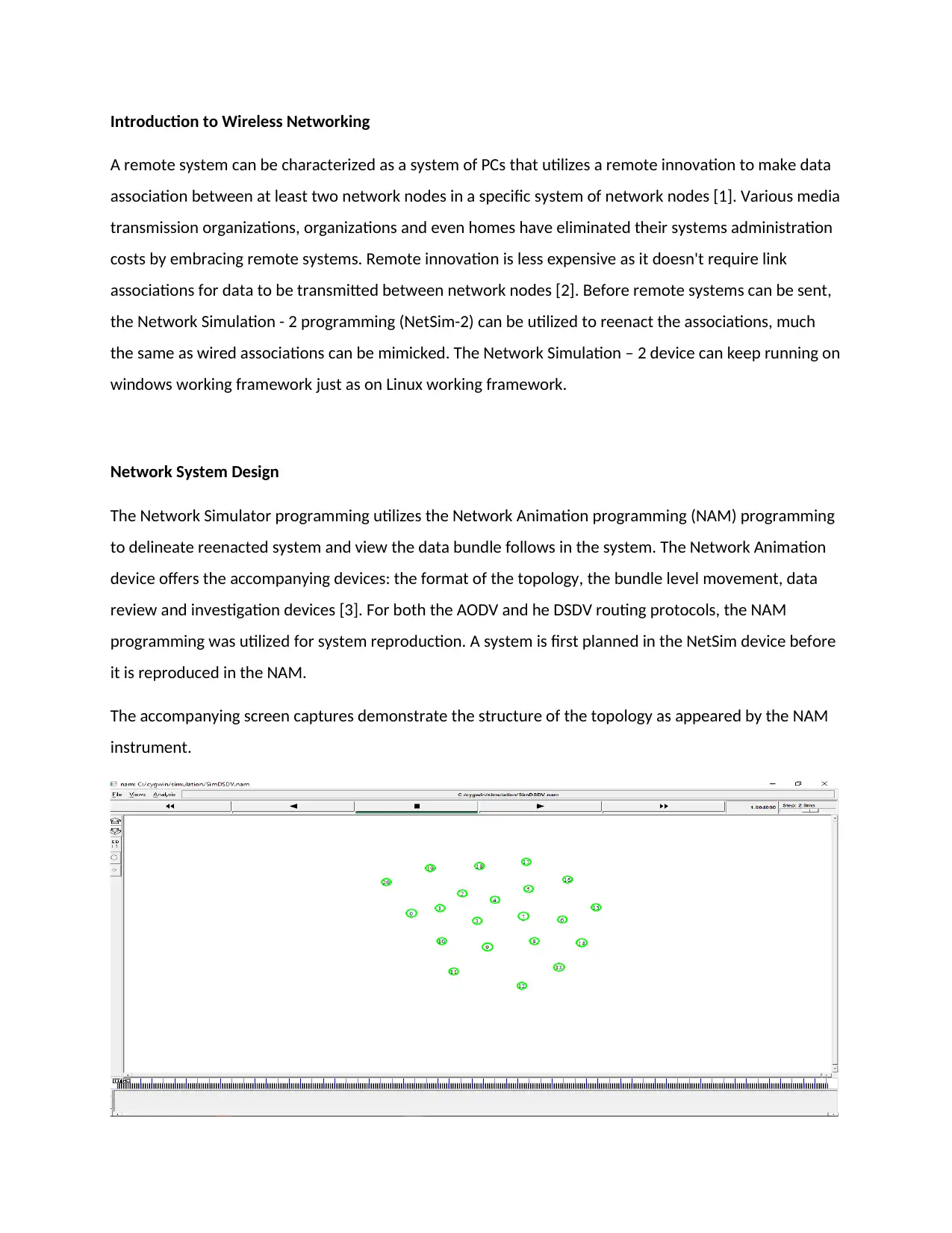
Introduction to Wireless Networking
A remote system can be characterized as a system of PCs that utilizes a remote innovation to make data
association between at least two network nodes in a specific system of network nodes [1]. Various media
transmission organizations, organizations and even homes have eliminated their systems administration
costs by embracing remote systems. Remote innovation is less expensive as it doesn't require link
associations for data to be transmitted between network nodes [2]. Before remote systems can be sent,
the Network Simulation - 2 programming (NetSim-2) can be utilized to reenact the associations, much
the same as wired associations can be mimicked. The Network Simulation – 2 device can keep running on
windows working framework just as on Linux working framework.
Network System Design
The Network Simulator programming utilizes the Network Animation programming (NAM) programming
to delineate reenacted system and view the data bundle follows in the system. The Network Animation
device offers the accompanying devices: the format of the topology, the bundle level movement, data
review and investigation devices [3]. For both the AODV and he DSDV routing protocols, the NAM
programming was utilized for system reproduction. A system is first planned in the NetSim device before
it is reproduced in the NAM.
The accompanying screen captures demonstrate the structure of the topology as appeared by the NAM
instrument.
A remote system can be characterized as a system of PCs that utilizes a remote innovation to make data
association between at least two network nodes in a specific system of network nodes [1]. Various media
transmission organizations, organizations and even homes have eliminated their systems administration
costs by embracing remote systems. Remote innovation is less expensive as it doesn't require link
associations for data to be transmitted between network nodes [2]. Before remote systems can be sent,
the Network Simulation - 2 programming (NetSim-2) can be utilized to reenact the associations, much
the same as wired associations can be mimicked. The Network Simulation – 2 device can keep running on
windows working framework just as on Linux working framework.
Network System Design
The Network Simulator programming utilizes the Network Animation programming (NAM) programming
to delineate reenacted system and view the data bundle follows in the system. The Network Animation
device offers the accompanying devices: the format of the topology, the bundle level movement, data
review and investigation devices [3]. For both the AODV and he DSDV routing protocols, the NAM
programming was utilized for system reproduction. A system is first planned in the NetSim device before
it is reproduced in the NAM.
The accompanying screen captures demonstrate the structure of the topology as appeared by the NAM
instrument.
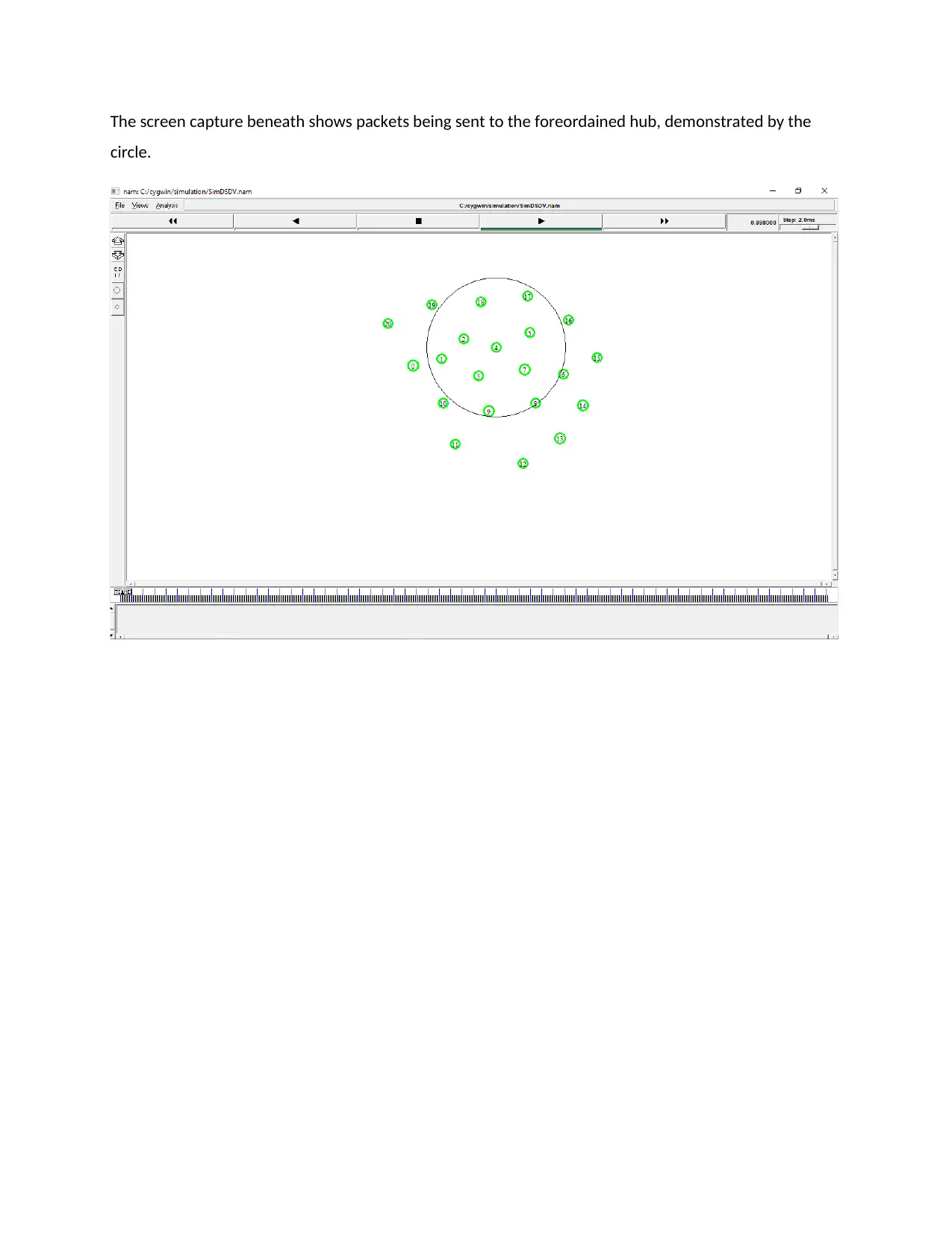
The screen capture beneath shows packets being sent to the foreordained hub, demonstrated by the
circle.
circle.
⊘ This is a preview!⊘
Do you want full access?
Subscribe today to unlock all pages.

Trusted by 1+ million students worldwide
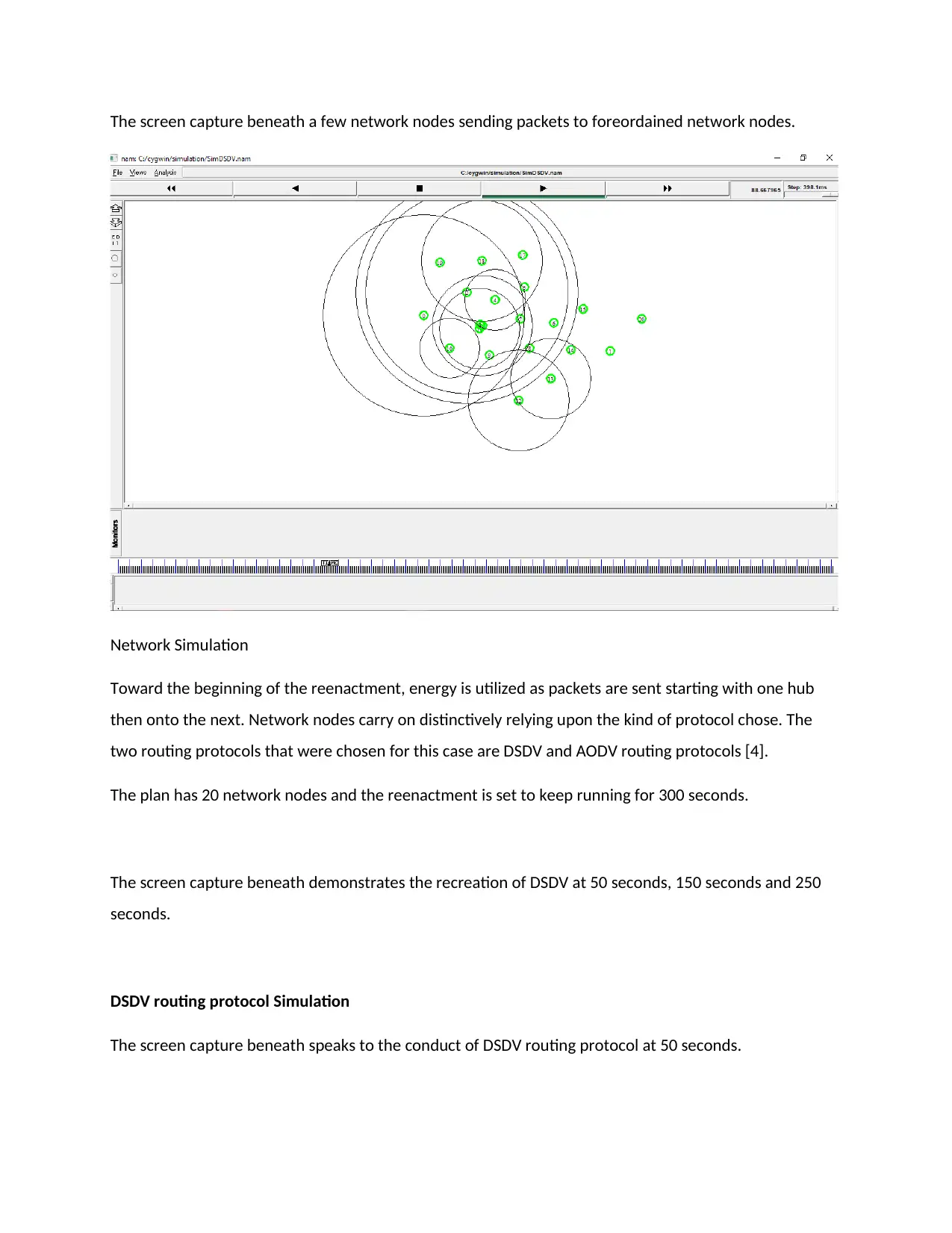
The screen capture beneath a few network nodes sending packets to foreordained network nodes.
Network Simulation
Toward the beginning of the reenactment, energy is utilized as packets are sent starting with one hub
then onto the next. Network nodes carry on distinctively relying upon the kind of protocol chose. The
two routing protocols that were chosen for this case are DSDV and AODV routing protocols [4].
The plan has 20 network nodes and the reenactment is set to keep running for 300 seconds.
The screen capture beneath demonstrates the recreation of DSDV at 50 seconds, 150 seconds and 250
seconds.
DSDV routing protocol Simulation
The screen capture beneath speaks to the conduct of DSDV routing protocol at 50 seconds.
Network Simulation
Toward the beginning of the reenactment, energy is utilized as packets are sent starting with one hub
then onto the next. Network nodes carry on distinctively relying upon the kind of protocol chose. The
two routing protocols that were chosen for this case are DSDV and AODV routing protocols [4].
The plan has 20 network nodes and the reenactment is set to keep running for 300 seconds.
The screen capture beneath demonstrates the recreation of DSDV at 50 seconds, 150 seconds and 250
seconds.
DSDV routing protocol Simulation
The screen capture beneath speaks to the conduct of DSDV routing protocol at 50 seconds.
Paraphrase This Document
Need a fresh take? Get an instant paraphrase of this document with our AI Paraphraser
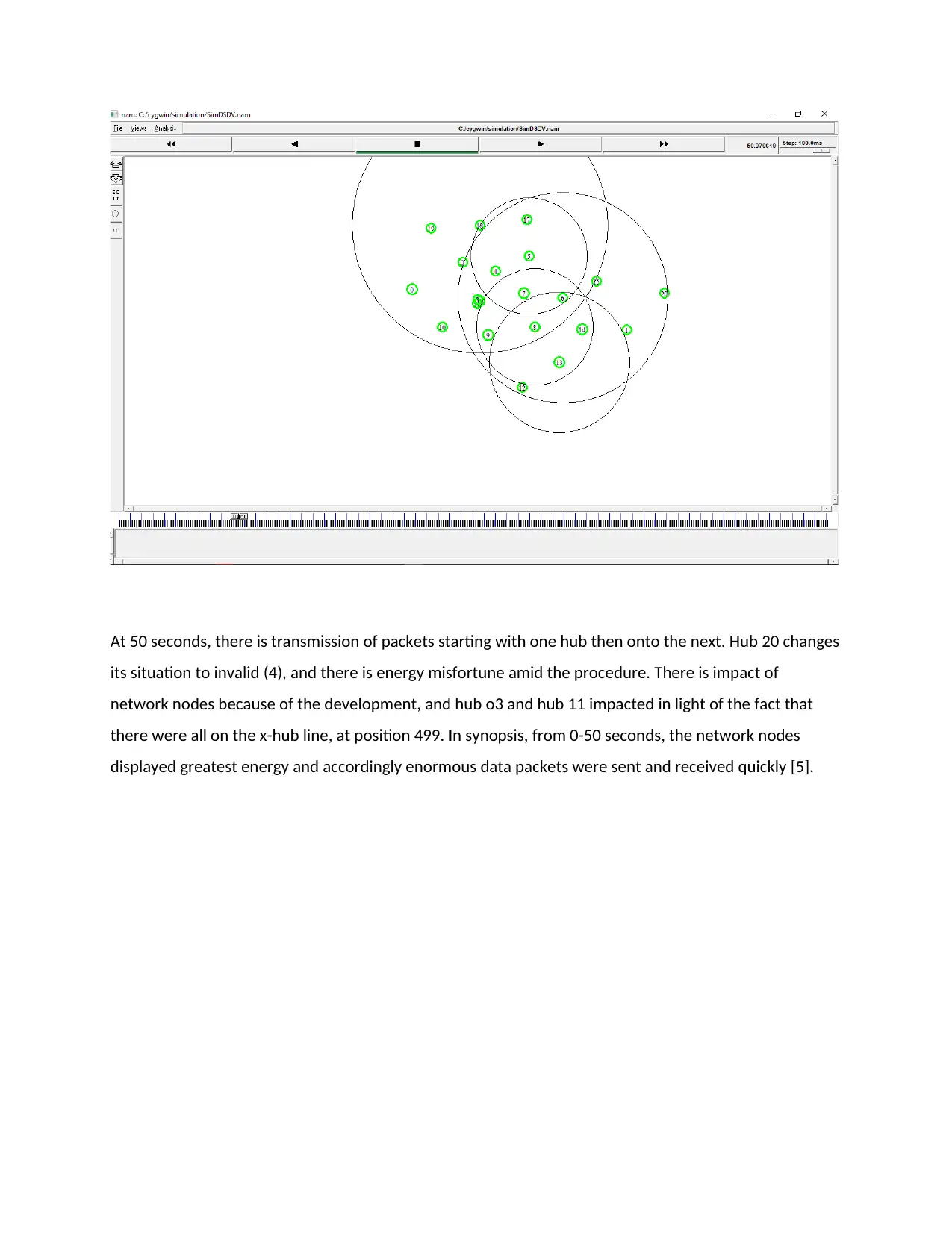
At 50 seconds, there is transmission of packets starting with one hub then onto the next. Hub 20 changes
its situation to invalid (4), and there is energy misfortune amid the procedure. There is impact of
network nodes because of the development, and hub o3 and hub 11 impacted in light of the fact that
there were all on the x-hub line, at position 499. In synopsis, from 0-50 seconds, the network nodes
displayed greatest energy and accordingly enormous data packets were sent and received quickly [5].
its situation to invalid (4), and there is energy misfortune amid the procedure. There is impact of
network nodes because of the development, and hub o3 and hub 11 impacted in light of the fact that
there were all on the x-hub line, at position 499. In synopsis, from 0-50 seconds, the network nodes
displayed greatest energy and accordingly enormous data packets were sent and received quickly [5].
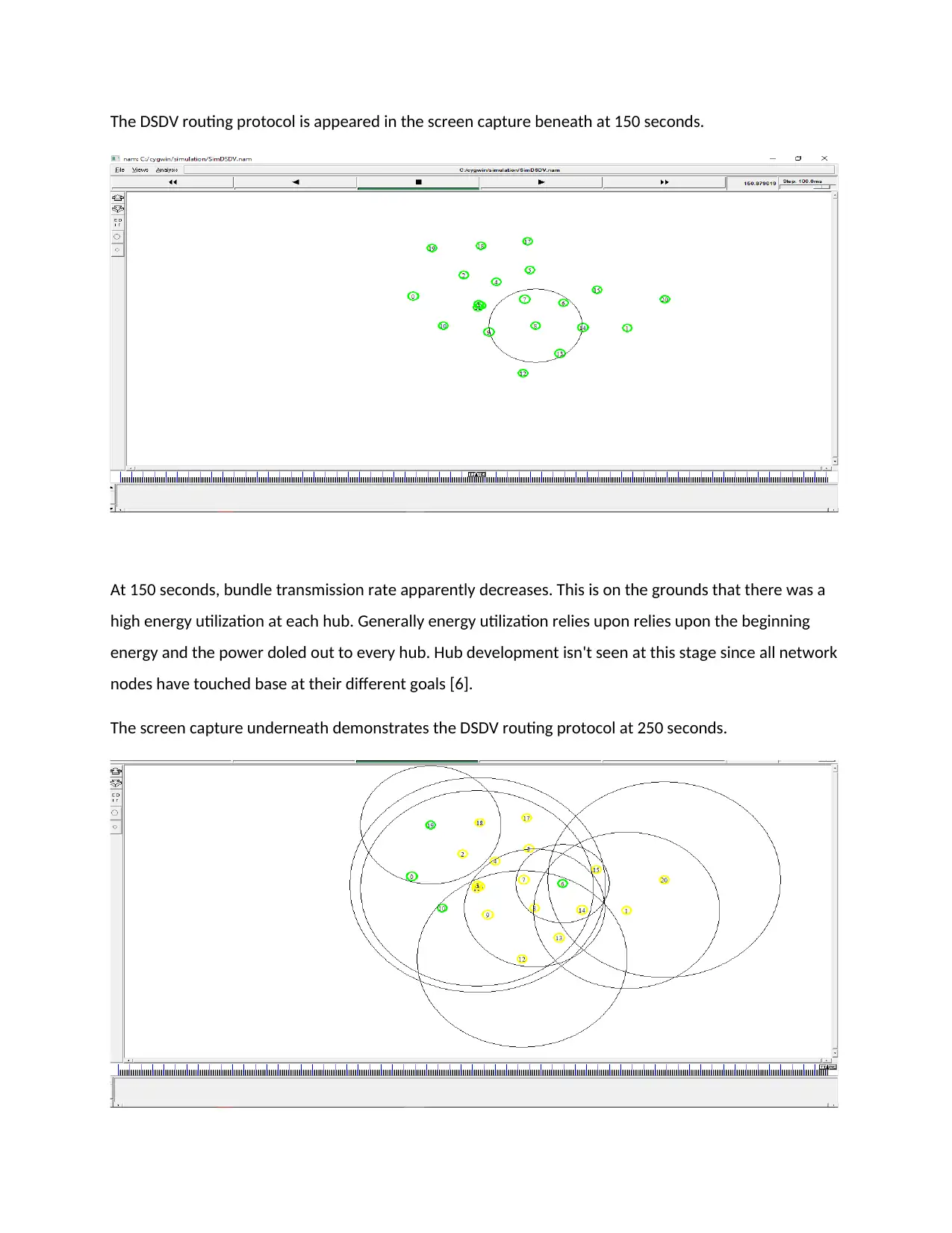
The DSDV routing protocol is appeared in the screen capture beneath at 150 seconds.
At 150 seconds, bundle transmission rate apparently decreases. This is on the grounds that there was a
high energy utilization at each hub. Generally energy utilization relies upon relies upon the beginning
energy and the power doled out to every hub. Hub development isn't seen at this stage since all network
nodes have touched base at their different goals [6].
The screen capture underneath demonstrates the DSDV routing protocol at 250 seconds.
At 150 seconds, bundle transmission rate apparently decreases. This is on the grounds that there was a
high energy utilization at each hub. Generally energy utilization relies upon relies upon the beginning
energy and the power doled out to every hub. Hub development isn't seen at this stage since all network
nodes have touched base at their different goals [6].
The screen capture underneath demonstrates the DSDV routing protocol at 250 seconds.
⊘ This is a preview!⊘
Do you want full access?
Subscribe today to unlock all pages.

Trusted by 1+ million students worldwide
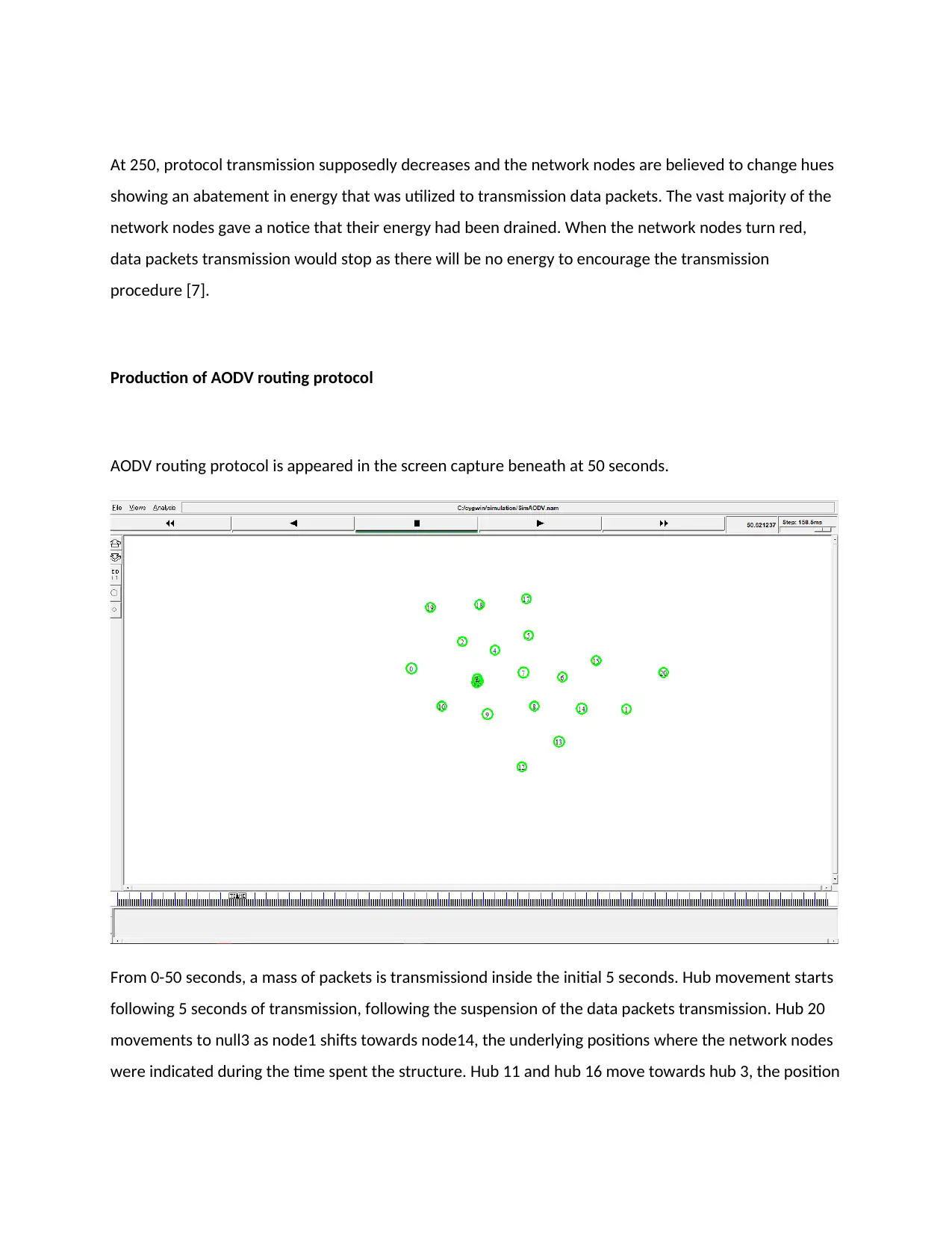
At 250, protocol transmission supposedly decreases and the network nodes are believed to change hues
showing an abatement in energy that was utilized to transmission data packets. The vast majority of the
network nodes gave a notice that their energy had been drained. When the network nodes turn red,
data packets transmission would stop as there will be no energy to encourage the transmission
procedure [7].
Production of AODV routing protocol
AODV routing protocol is appeared in the screen capture beneath at 50 seconds.
From 0-50 seconds, a mass of packets is transmissiond inside the initial 5 seconds. Hub movement starts
following 5 seconds of transmission, following the suspension of the data packets transmission. Hub 20
movements to null3 as node1 shifts towards node14, the underlying positions where the network nodes
were indicated during the time spent the structure. Hub 11 and hub 16 move towards hub 3, the position
showing an abatement in energy that was utilized to transmission data packets. The vast majority of the
network nodes gave a notice that their energy had been drained. When the network nodes turn red,
data packets transmission would stop as there will be no energy to encourage the transmission
procedure [7].
Production of AODV routing protocol
AODV routing protocol is appeared in the screen capture beneath at 50 seconds.
From 0-50 seconds, a mass of packets is transmissiond inside the initial 5 seconds. Hub movement starts
following 5 seconds of transmission, following the suspension of the data packets transmission. Hub 20
movements to null3 as node1 shifts towards node14, the underlying positions where the network nodes
were indicated during the time spent the structure. Hub 11 and hub 16 move towards hub 3, the position
Paraphrase This Document
Need a fresh take? Get an instant paraphrase of this document with our AI Paraphraser
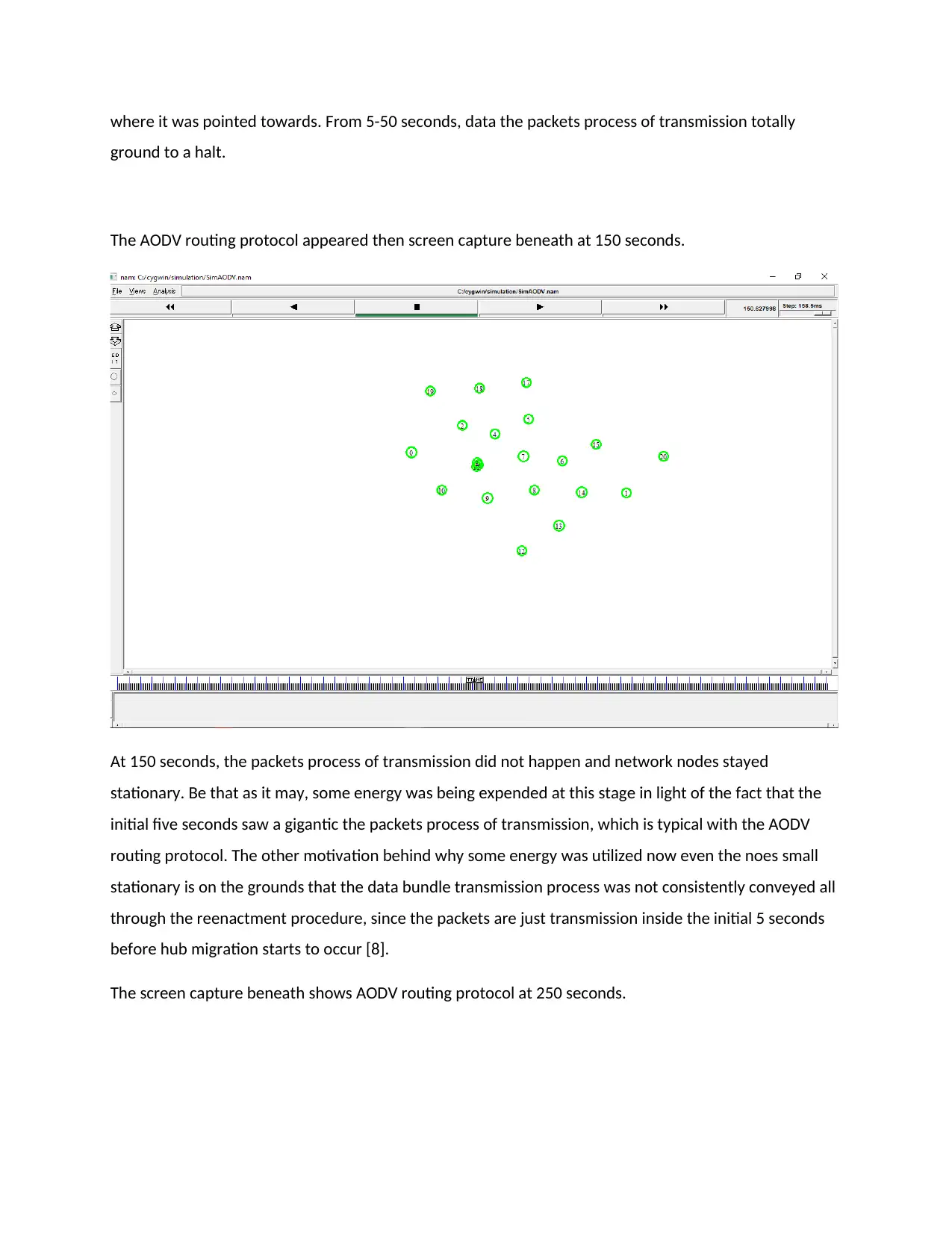
where it was pointed towards. From 5-50 seconds, data the packets process of transmission totally
ground to a halt.
The AODV routing protocol appeared then screen capture beneath at 150 seconds.
At 150 seconds, the packets process of transmission did not happen and network nodes stayed
stationary. Be that as it may, some energy was being expended at this stage in light of the fact that the
initial five seconds saw a gigantic the packets process of transmission, which is typical with the AODV
routing protocol. The other motivation behind why some energy was utilized now even the noes small
stationary is on the grounds that the data bundle transmission process was not consistently conveyed all
through the reenactment procedure, since the packets are just transmission inside the initial 5 seconds
before hub migration starts to occur [8].
The screen capture beneath shows AODV routing protocol at 250 seconds.
ground to a halt.
The AODV routing protocol appeared then screen capture beneath at 150 seconds.
At 150 seconds, the packets process of transmission did not happen and network nodes stayed
stationary. Be that as it may, some energy was being expended at this stage in light of the fact that the
initial five seconds saw a gigantic the packets process of transmission, which is typical with the AODV
routing protocol. The other motivation behind why some energy was utilized now even the noes small
stationary is on the grounds that the data bundle transmission process was not consistently conveyed all
through the reenactment procedure, since the packets are just transmission inside the initial 5 seconds
before hub migration starts to occur [8].
The screen capture beneath shows AODV routing protocol at 250 seconds.
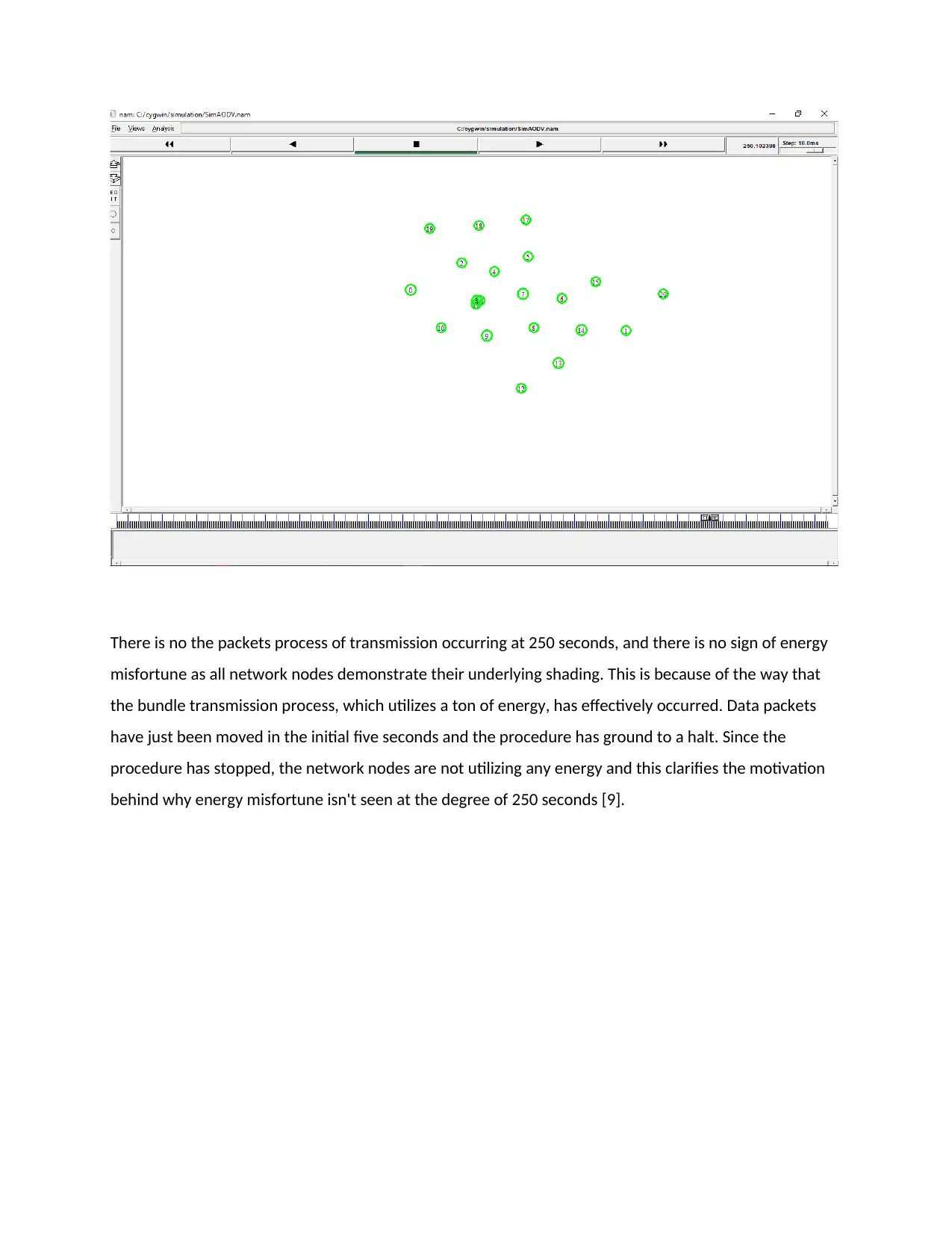
There is no the packets process of transmission occurring at 250 seconds, and there is no sign of energy
misfortune as all network nodes demonstrate their underlying shading. This is because of the way that
the bundle transmission process, which utilizes a ton of energy, has effectively occurred. Data packets
have just been moved in the initial five seconds and the procedure has ground to a halt. Since the
procedure has stopped, the network nodes are not utilizing any energy and this clarifies the motivation
behind why energy misfortune isn't seen at the degree of 250 seconds [9].
misfortune as all network nodes demonstrate their underlying shading. This is because of the way that
the bundle transmission process, which utilizes a ton of energy, has effectively occurred. Data packets
have just been moved in the initial five seconds and the procedure has ground to a halt. Since the
procedure has stopped, the network nodes are not utilizing any energy and this clarifies the motivation
behind why energy misfortune isn't seen at the degree of 250 seconds [9].
⊘ This is a preview!⊘
Do you want full access?
Subscribe today to unlock all pages.

Trusted by 1+ million students worldwide

Analyzing of Trace file record
DSDV routing Protocol Trace file
At precisely 0.004166565 seconds, hub 0 sends a bundle with a clear message and there is no energy
utilization that happens. The energy at the hub in this way is kept at 60 joules. At precisely 0.004262
seconds, energy misfortune is seen in every one of the network nodes, with network nodes losing
practically the entirety of their energy. This is on the grounds that the bundle transmission process has
just started [10].
From 0.004981773 to 0.005007365 seconds, the packets process of transmission process had effectively
finished. Energy was spent amid this stage and subsequently an energy drop was seen in every one of
the network nodes. The bundle transmission process went on from 0.005007365 seconds with a
consistent energy decrease in light of the exercises occurring in the packets process of transmission
process, that is, sending and accepting of packets. This procedure devours energy.
By 0.005007365 seconds, all data packets have achieved their different goals. Energy in each hub has
diminished to 59.999358 joules. Data the packets process of transmission process proceeds with a
consistent loss of energy[10].
The reenactment procedure ground to a halt a far distance 300 seconds, and 30 joules of energy was
spent altogether. While the various network nodes dropped their energy to 30 joules, 4 network nodes
had the capacity to hold some energy. Notwithstanding, it was seen that there was no hub that had
totally spent its energy. Before the finish of the recreation, 846 data packets had been received.
AODV routing Protocol Trace file
Network nodes began sending packets at 1 seconds precisely, with every hub having 60 joules of energy.
Monstrous bundle transmission was observers n the initial 5 seconds, and data dropped basically amid
this stage. A drop in energy was seen in 5 seconds, after which energy stayed steady as there was no
more data transmission process occurring [10].
A the packets process of that was sent by hub 19 bound for hub 19 was dropped before it achieved its
goal due to a crash. The impact occurred at hub 0. About the sum total of what packets have been
believed to drop at hub 0.
DSDV routing Protocol Trace file
At precisely 0.004166565 seconds, hub 0 sends a bundle with a clear message and there is no energy
utilization that happens. The energy at the hub in this way is kept at 60 joules. At precisely 0.004262
seconds, energy misfortune is seen in every one of the network nodes, with network nodes losing
practically the entirety of their energy. This is on the grounds that the bundle transmission process has
just started [10].
From 0.004981773 to 0.005007365 seconds, the packets process of transmission process had effectively
finished. Energy was spent amid this stage and subsequently an energy drop was seen in every one of
the network nodes. The bundle transmission process went on from 0.005007365 seconds with a
consistent energy decrease in light of the exercises occurring in the packets process of transmission
process, that is, sending and accepting of packets. This procedure devours energy.
By 0.005007365 seconds, all data packets have achieved their different goals. Energy in each hub has
diminished to 59.999358 joules. Data the packets process of transmission process proceeds with a
consistent loss of energy[10].
The reenactment procedure ground to a halt a far distance 300 seconds, and 30 joules of energy was
spent altogether. While the various network nodes dropped their energy to 30 joules, 4 network nodes
had the capacity to hold some energy. Notwithstanding, it was seen that there was no hub that had
totally spent its energy. Before the finish of the recreation, 846 data packets had been received.
AODV routing Protocol Trace file
Network nodes began sending packets at 1 seconds precisely, with every hub having 60 joules of energy.
Monstrous bundle transmission was observers n the initial 5 seconds, and data dropped basically amid
this stage. A drop in energy was seen in 5 seconds, after which energy stayed steady as there was no
more data transmission process occurring [10].
A the packets process of that was sent by hub 19 bound for hub 19 was dropped before it achieved its
goal due to a crash. The impact occurred at hub 0. About the sum total of what packets have been
believed to drop at hub 0.
Paraphrase This Document
Need a fresh take? Get an instant paraphrase of this document with our AI Paraphraser
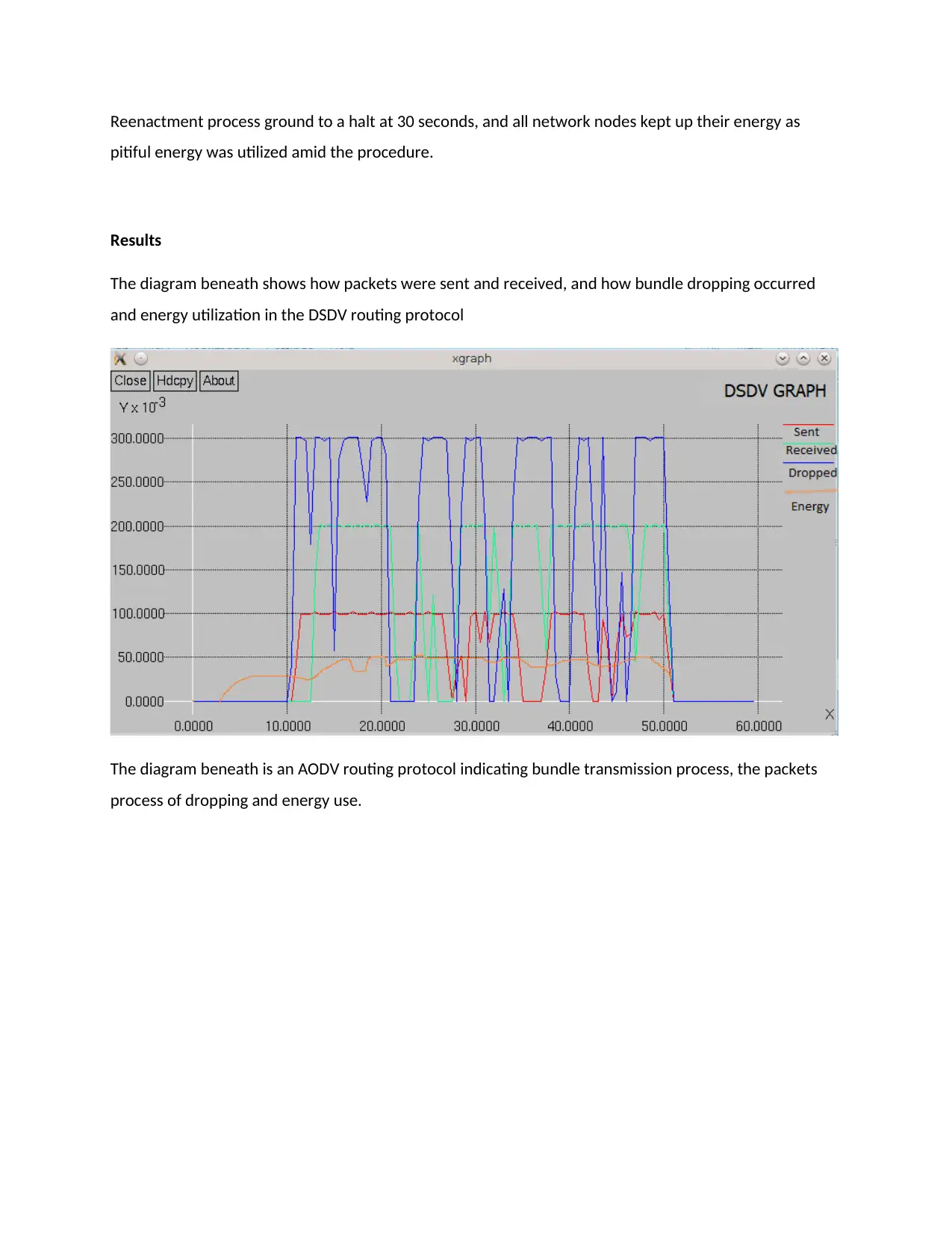
Reenactment process ground to a halt at 30 seconds, and all network nodes kept up their energy as
pitiful energy was utilized amid the procedure.
Results
The diagram beneath shows how packets were sent and received, and how bundle dropping occurred
and energy utilization in the DSDV routing protocol
The diagram beneath is an AODV routing protocol indicating bundle transmission process, the packets
process of dropping and energy use.
pitiful energy was utilized amid the procedure.
Results
The diagram beneath shows how packets were sent and received, and how bundle dropping occurred
and energy utilization in the DSDV routing protocol
The diagram beneath is an AODV routing protocol indicating bundle transmission process, the packets
process of dropping and energy use.
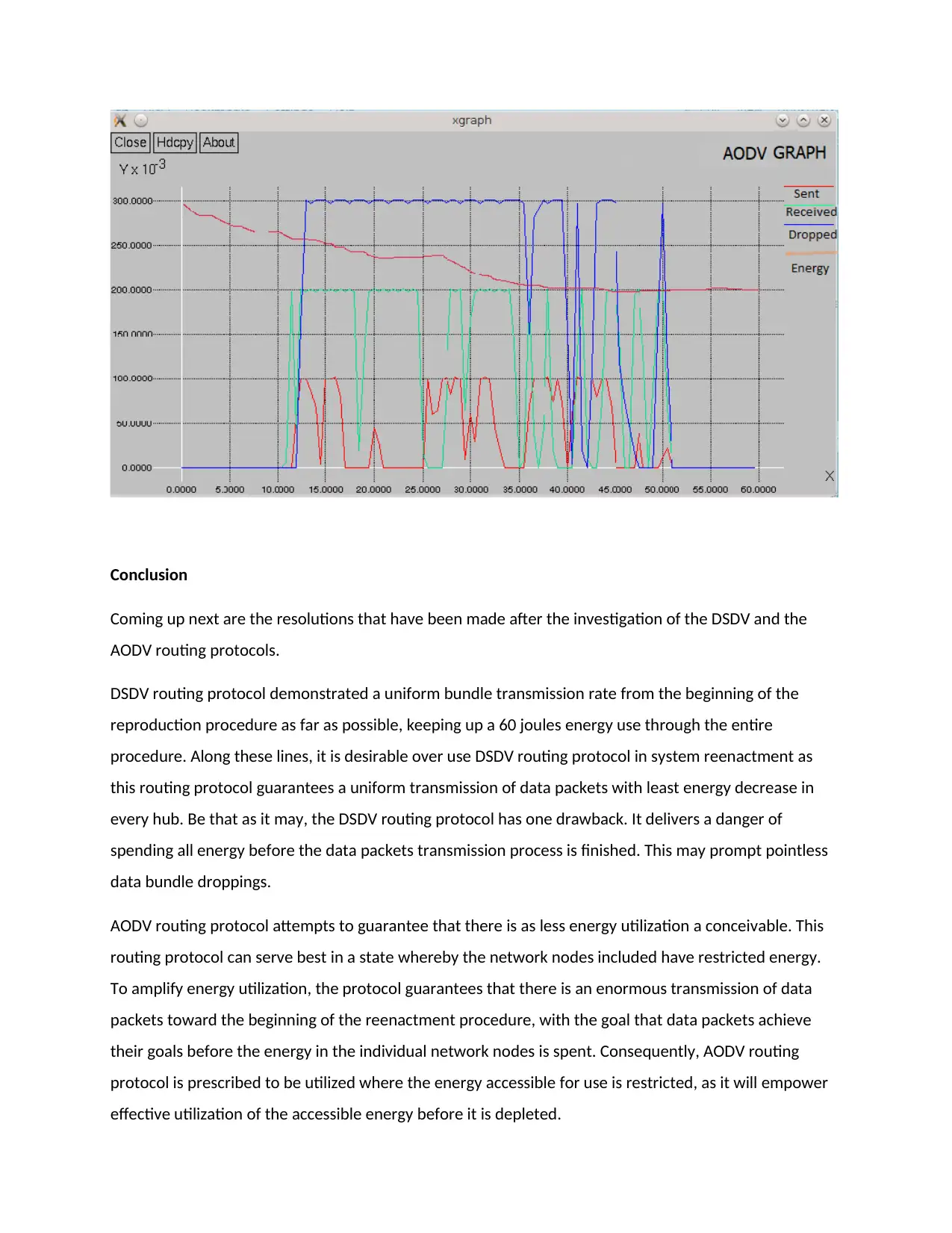
Conclusion
Coming up next are the resolutions that have been made after the investigation of the DSDV and the
AODV routing protocols.
DSDV routing protocol demonstrated a uniform bundle transmission rate from the beginning of the
reproduction procedure as far as possible, keeping up a 60 joules energy use through the entire
procedure. Along these lines, it is desirable over use DSDV routing protocol in system reenactment as
this routing protocol guarantees a uniform transmission of data packets with least energy decrease in
every hub. Be that as it may, the DSDV routing protocol has one drawback. It delivers a danger of
spending all energy before the data packets transmission process is finished. This may prompt pointless
data bundle droppings.
AODV routing protocol attempts to guarantee that there is as less energy utilization a conceivable. This
routing protocol can serve best in a state whereby the network nodes included have restricted energy.
To amplify energy utilization, the protocol guarantees that there is an enormous transmission of data
packets toward the beginning of the reenactment procedure, with the goal that data packets achieve
their goals before the energy in the individual network nodes is spent. Consequently, AODV routing
protocol is prescribed to be utilized where the energy accessible for use is restricted, as it will empower
effective utilization of the accessible energy before it is depleted.
Coming up next are the resolutions that have been made after the investigation of the DSDV and the
AODV routing protocols.
DSDV routing protocol demonstrated a uniform bundle transmission rate from the beginning of the
reproduction procedure as far as possible, keeping up a 60 joules energy use through the entire
procedure. Along these lines, it is desirable over use DSDV routing protocol in system reenactment as
this routing protocol guarantees a uniform transmission of data packets with least energy decrease in
every hub. Be that as it may, the DSDV routing protocol has one drawback. It delivers a danger of
spending all energy before the data packets transmission process is finished. This may prompt pointless
data bundle droppings.
AODV routing protocol attempts to guarantee that there is as less energy utilization a conceivable. This
routing protocol can serve best in a state whereby the network nodes included have restricted energy.
To amplify energy utilization, the protocol guarantees that there is an enormous transmission of data
packets toward the beginning of the reenactment procedure, with the goal that data packets achieve
their goals before the energy in the individual network nodes is spent. Consequently, AODV routing
protocol is prescribed to be utilized where the energy accessible for use is restricted, as it will empower
effective utilization of the accessible energy before it is depleted.
⊘ This is a preview!⊘
Do you want full access?
Subscribe today to unlock all pages.

Trusted by 1+ million students worldwide
1 out of 29
Related Documents
Your All-in-One AI-Powered Toolkit for Academic Success.
+13062052269
info@desklib.com
Available 24*7 on WhatsApp / Email
![[object Object]](/_next/static/media/star-bottom.7253800d.svg)
Unlock your academic potential
Copyright © 2020–2025 A2Z Services. All Rights Reserved. Developed and managed by ZUCOL.





